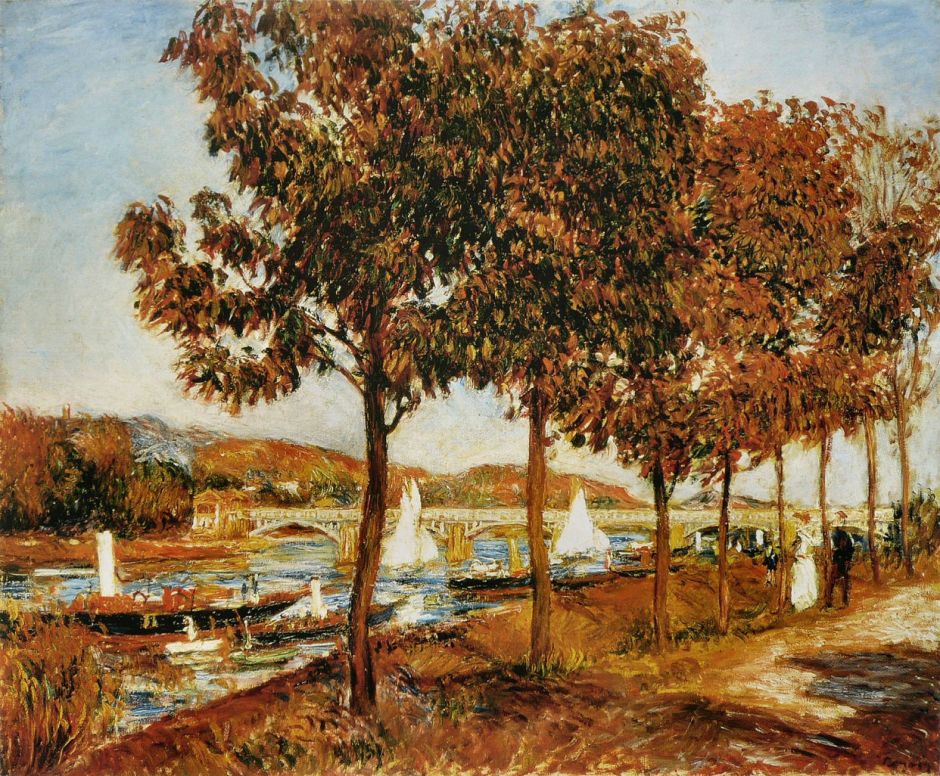Impressionists at Argenteuil 2
Following their return to the outskirts of Paris after the Franco-Prussian war and Paris Commune, Alfred Sisley, Claude Monet and Auguste Renoir had painted in and around the Monets’ home in Argenteuil on the north bank of the River Seine. Monet commuted into the city by train, the Sisleys shared their house, and Renoir visited in the summer.

Édouard Manet was another visitor, and painted this oil sketch of Claude Monet in Argenteuil in 1874, showing Monet working in his floating studio. His position in the boat appears relaxed, but would have become uncomfortable if maintained for long, as he would have had to keep bending forward to paint, suggesting he might have posed for this painting.
In 1876, Monet’s wife Camille became seriously ill, deteriorating further with the birth of their second son in 1878. The family moved to share a house with his patron Ernest Hoschedé in Vétheuil, further out to the north-west. The Sisleys moved to Moret-sur-Loing on the opposite side of Paris, leaving only Renoir to continue his summer visits.

Renoir’s The Boating Party at Chatou (1879) shows watersports taking place further down the river, with a combination of social rowing in the foreground, and two sports rowers further out in the river.

Renoir’s By the Water from about 1880 is believed to have been painted on the terrace of the Restaurant Fournaise on the Île de Chatou, which he was soon to use for his major work Luncheon of the Boating Party (below). If that’s the case, then what appears to be a lake in the background is really the River Seine.

During the summer of 1880, Renoir started work on another of his masterpieces, that he didn’t complete until the following year: Luncheon of the Boating Party (1880-81), with its complex group of figures.
This was again set on the Île de Chatou at the Restaurant Fournaise, and funded by commissioned portraits over this period. Among his models are his partner and later wife Aline Charigot (left foreground, with affenpinscher dog), the actress Jeanne Samary (upper right), and fellow artist Gustave Caillebotte (seated, lower right). This was exhibited at the Seventh Impressionist Exhibition in 1882, where it was praised by several critics.

Later in 1882, Renoir painted The Bridge at Argenteuil in Autumn, close to another bridge over the river for which Monet had a particular affection.
In 1881, Gustave Caillebotte acquired a property at Petit-Gennevilliers, near Argenteuil, where he had a boatyard, and moved there permanently in 1888. He and Renoir maintained the tradition of painting this section of the River Seine.

Caillebotte’s Boat Moored on the Seine at Argenteuil from about 1884 has thoroughly Impressionist style and facture, with its obvious brushstrokes forming the broken reflection of the boat on the water, and even detail through the depth of the painting.

Although Caillebotte didn’t make formal series of views that became such a feature of the art of Monet and Pissarro, in the mid-1880s he painted several views of the modern bridges over the River Seine near Argenteuil. The Bridge at Argenteuil and the Seine (1885) is Impressionist in style, with its broken water surface. This features a steam paddle tug towing a laden barge towards the next bridge, which I think is the railway bridge that Claude Monet painted at least twice.
In 1888, Renoir spent the summer painting at Argenteuil and Bougival, where he rediscovered his landscape form.

Renoir’s The Seine at Argenteuil from 1888 is another view of leisure boating, painted in a style more similar to Sisley’s high Impressionist landscapes, with coarse high chroma brushstrokes laid to form the surface of the water.

For Gustave Caillebotte and his friends, this was the place to come to enjoy a day’s sailing, as shown in his late painting of Sailboats on the Seine at Argenteuil from 1892, just two years before his untimely death at the age of only forty-five. With that, Argenteuil and Chatou were abandoned and Impressionism moved on.